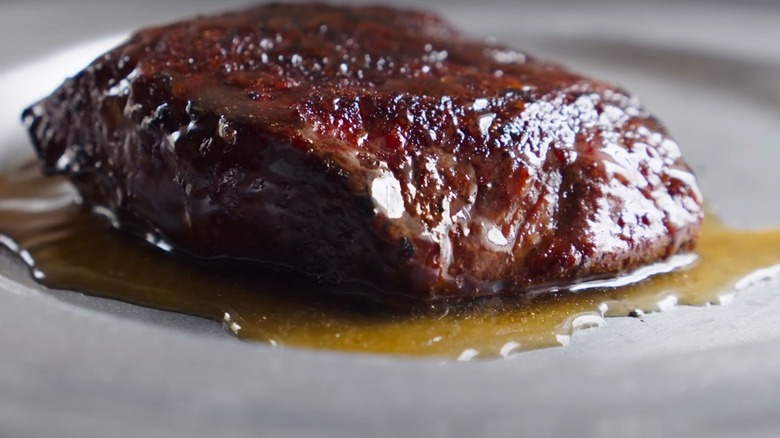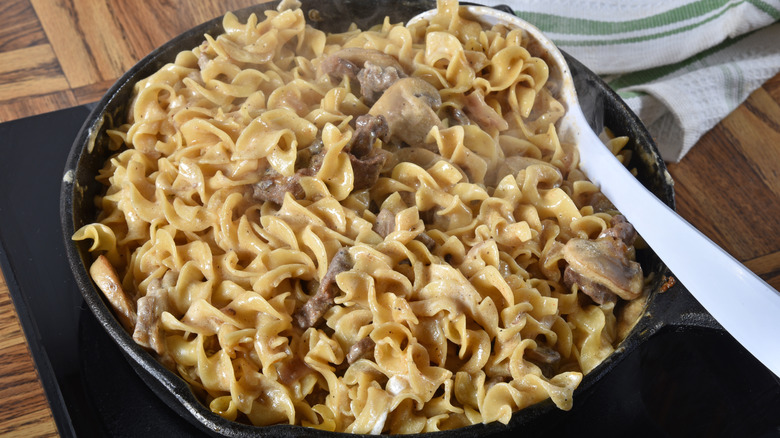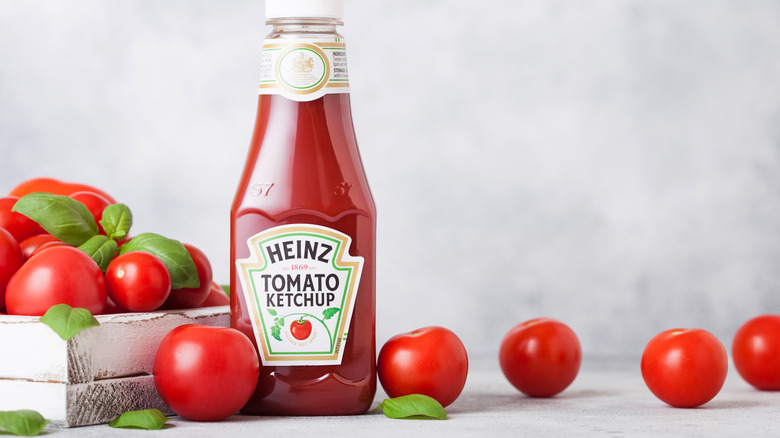Mushroom Ketchup: How To Properly Use The Umami-Packed Sauce
We may receive a commission on purchases made from links.
Mushroom ketchup? Whose crazy idea is this? Well, this might come as a surprise to you, but ketchup used to be made from mushrooms (and a whole lot of other non-tomato ingredients). Ketchup originated over 2,000 years ago in Southern China. In fact, its very name comes from the Hokkien Chinese word "kê-tsiap," which originally referred to a pasty sauce made from fermented fish entrails. The product eventually spread throughout Southeast Asia before it was introduced to European traders around the late 1600s. They took samples back with them to their respective homelands, launching a ketchup craze in the West. It became particularly popular in 18th century Britain when the first recipe for "English Katchup" appeared in Eliza Smith's seminal cookbook "The Compleat Housewife." The final line of the recipe reads: "You may add to it the clear Liquor that comes from Mushrooms."
Smith's recipe also included shallots, anchovies, horseradish, ginger, mace, lemon peel, and cloves. These were dissolved into a mixture of white wine and vinegar. Other recipes for mushroom ketchup actually include finely diced mushrooms themselves as a base for the sauce, and while there is a good deal of variation from one recipe to the next, the common thread has always been the use of vinegar. This solution served the vital purpose of preserving perishable ingredients like fish and mushrooms in the era before refrigeration. Eliza Smith advises readers to serve her ketchup with "any dish of meat," and other recipes for mushroom ketchup typically recommend the same. There's actually some curious reasoning behind this.
Mushrooms and meat are a match made in heaven
Eliza Smith and other mushroom ketchup makers are expanding upon a tried-and-true culinary mashup when they recommend pairing their recipes with meat. Mushrooms and red meat are a classic combination, as evidenced by legendary dishes like beef wellington and beef stroganoff. The reason that this pairing works so well is because mushrooms and red meat both contain glutamate, an essential amino acid that also happens to be the basis of umami. Umami — sometimes referred to as savoriness — is one of the five fundamental flavors (alongside salty, sweet, sour, and bitter). Though it was not officially identified by scientists until the early 1900s, it has long played a role in our kitchens, being perhaps the most enigmatic of all the flavors simply by virtue of its complexity.
When you pair mushrooms with red meat, each element enhances the other, creating an explosion of rich umami flavor on your palate. This is especially true of mushroom ketchup because it is often fermented in vinegar, and fermented foods are rich sources of umami. Interestingly enough, tomatoes contain glutamate as well, and we all know how popular tomato ketchup on burgers is. The same wisdom applies to mushroom ketchup — it would pair perfectly with a thick steakhouse-style burger. And since mushroom ketchup does not carry the same reputation as the tomato kind (a reputation that, let's face it, is rather lowbrow), you can freely douse it on a steak without fearing judgment. Don't stop at beef either, as mushroom ketchup marries nicely with lamb chops.
Don't sleep on other varieties of ketchup
If you had never heard of mushroom ketchup before reading this article, you're in good company. Despite being an older iteration than tomato ketchup, it's been largely forgotten — at least in the United States. For this, we can blame one Henry J. Heinz, whose eponymous condiment company took over the ketchup world in the late 19th century. The first widely-published recipe for tomato ketchup came from Philadelphian James Mease in 1812, but it was over six decades later, in 1876, that the H.J. Heinz Company first began selling it. Heinz ketchup was a massive success from the get-go, and, thanks to the convenient nature of Heinz's patented bottles, it ultimately replaced the tradition of making ketchup at home — a tradition that had led to much more variety.
Nowadays, tomato ketchup has become ubiquitous to the point that some people think the phrase is redundant. ("Doesn't ketchup contain tomatoes by nature?" they say.) The fact of the matter is, there were once dozens of different types of ketchup. Some contained mushrooms, others contained seafood like anchovies, oysters, or mussels. There were even versions of ketchup based on cucumbers, peaches, and walnuts. It's a shame that these unique takes on the condiment have been all but forgotten in the wake of Heinz's dominance, but fortunately, recipes from past centuries — as well as the present day — can be found all over the internet. Mushroom ketchup was particularly popular in its heyday, and while you aren't likely to find it in many supermarkets, you can actually purchase bottles of it online.


